
Yangtze or Yangzi is the longest river in Eurasia, the third-longest in the world, and the longest in the world to flow entirely within one country. It rises at Jari Hill in the Tanggula Mountains of the Tibetan Plateau and flows 6,300 km (3,915 mi) in a generally easterly direction to the East China Sea. It is the fifth-largest primary river by discharge volume in the world. Its drainage basin comprises one-fifth of the land area of China, and is home to nearly one-third of the country's population.
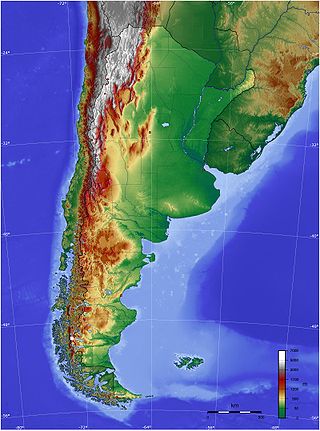
The geography of Argentina is heavily diverse, consisting of the Andes Mountains, pampas, and various rivers and lakes. Bordered by the Andes in the west and the South Atlantic Ocean to the east, its neighbouring countries are Chile to the west, Bolivia and Paraguay to the north, and Brazil and Uruguay to the northeast.
Lake Torrens National Park is a protected area located in South Australia about 345 kilometres north of the Adelaide city centre. Material published by the national park's manager reports that:
The stark wilderness and the salt lake that stretches 250km in length make up the Lake Torrens National Park. Lake Torrens is usually a dry salt flat. It has only been filled with water once in the past 150 years. Thunderstorms occasionally provide a small amount of water in the lake, when this occurs the area attracts a variety of birdlife. The park's landscape provides opportunities for photography and studying geology.
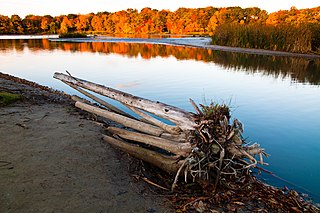
Rouge National Urban Park is a national urban park in Ontario, Canada. The park is centred around the Rouge River and its tributaries in the Greater Toronto Area. The southern portion of the park is situated around the mouth of the river in Toronto, and extends northwards into Markham, Pickering, Uxbridge, and Whitchurch-Stouffville.
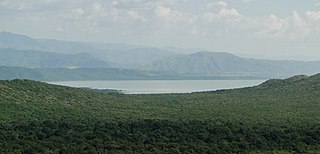
Lake Chamo is a lake in the Southern Nations, Nationalities, and Peoples' Region of southern Ethiopia. Located in the Main Ethiopian Rift, it is at an elevation of 1,110 meters. The Chamo lake is just to the south of Lake Abaya and the city of Arba Minch, east of the Guge Mountains, and west of the Amaro Mountains.
Mahagnao Volcano also known as part of is a dormant stratovolcano located in the Barangay Mahagnao part of the municipality of Burauen province of Leyte, Philippines. It is also bounded by the municipalities of La Paz and MacArthur. The area is mostly composed of wetland forests and also the birth of many rivers and streams flowing on many part of Burauen and on its neighboring towns.
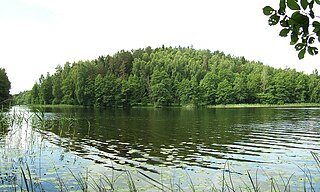
Labanoras Regional Park, established in 1992, is located 80 kilometers northeast of Lithuania's capital, Vilnius. Covering 553.18 km2, it is the largest regional park in the country. Its administration is in the small town of Labanoras.

The Paroo-Darling National Park is a protected national park that is located in the Far West region of New South Wales, in eastern Australia. The 178,053-hectare (439,980-acre) national park spans two distinct regions in the outback area. This region covers the arid catchments of the Paroo River and the Paroo-Darling confluence to the south.

Kolkheti National Park, is a national park located in Samegrelo-Zemo Svaneti and Guria in the historical region of Colchis in western Georgia. The wetlands of Central Kolkheti are a Wetland of International Importance, a Ramsar Site. It lies on a coastal plain on the Black Sea, between the mouths of the Tikori and Supsa and spanning the districts of Zugdidi, Khobi, Lanchkhuti, Senaki and Abasha. The park was established during 1998 and 1999 as part of Georgia's Integrated Coastal Management Project, which was backed financially by the World Bank (WB) and the Global Environmental Facility (GEF). Kolkheti National Park covers an area of 28,940 hectares and with protected wetlands protected area spans to 33710 hectares, incorporating the land of the former 500-hectare Kolkheti State Nature Reserve, which had been established in 1947, and its surrounding wetlands, including the lake Paliastomi. Because of its unique forests and wetlands, and high numbers of threatened species, the park was inscribed on the UNESCO World Heritage List as part of the Colchic Rainforests and Wetlands site in 2021.

Gokyo Lakes are oligotrophic lakes in Nepal's Sagarmatha National Park, located at an altitude of 4,700–5,000 m (15,400–16,400 ft) above sea level. Lakes and resorts were named after Gokyo Ri peak. These lakes are the world's highest freshwater lake system comprising six main lakes, of which Thonak Lake is the largest. In September 2007, Gokyo and its associated wetlands of 7,770 ha (30.0 sq mi) have been designated a Ramsar site.
The Kigosi National Park (Hifadhi ya Taifa ya Kigosi, In Swahili) is a national park located in Shinyanga Region, Geita Region and northwest Tabora Region of Tanzania. In 2019, Kigosi National Park was created. Kigosi National Park was established in 2019. It is a part of the Moyowosi/Malagarasi wetlands complex, which is the largest wetlands complex in East Africa, and has an area of 8,265 km2. The Malagarasi, Moyowosi, Nikonga, Ugalla, Kigosi, Nikonga, and Gombe are seven slow-moving rivers that meander through a vast and intricate network of marshes, plains lakes, and woodlands. These rivers should not be confused with the Gombe Stream National Park where the chimpanzees live. These rivers eventually combine to form the Malagarasi River, which empties into Ilagala's Lake Tanganyika. With a total area of almost 92,000 square kilometers, the wetland system is larger than the entire country of Portugal.

The Coongie Lakes is a freshwater wetland system located in the Far North region of South Australia. The 21,790-square-kilometre (8,410 sq mi) lakes system is located approximately 1,046 kilometres north of the Adelaide city centre. The wetlands includes lakes, channels, billabongs, shallow floodplains, deltas, and interdune swamps. It lies on the floodplain of Cooper Creek, an ephemeral river flowing through a desert landscape in the Lake Eyre Basin which rarely, after occasional large floods, empties into Lake Eyre. The wetland system has been recognised both as being of international importance by designation under the Ramsar Convention with a listing on 15 June 1987 and being nationally important within Australia with a listing in A Directory of Important Wetlands in Australia (DIWA). Its extent includes the regional town of Innamincka, the Malkumba-Coongie Lakes National Park, the Innamincka Regional Reserve, the Strzelecki Regional Reserve and the Coongie Lakes Important Bird Area.
Malkumba-Coongie Lakes National Park is a protected area located in the north-east of South Australia about 110 kilometres north-west of Innamincka.

The Najafgarh drain or Najafgarh nalah, which also acts as Najafgarh drain bird sanctuary, is another name for the northernmost end of River Sahibi, which continues its flow through Delhi, where it is channelized, and then flows into the Yamuna. Within Delhi, due to its channelization for flood control purposes, it is now erroneously called "Najafgarh drain" or "Najafgarh nullah." It gets this name from the once famous and huge Najafgarh Jheel (lake) near the town of Najafgarh in southwest Delhi and within urbanized Delhi. It is the Indian capital’s most polluted water body due to direct inflow of untreated sewage from surrounding populated areas. A January 2005 report by the Central Pollution Control Board classifies this drain, with 13 other highly polluted wetlands, under category ‘‘D’’ for assessing the water quality of wetlands in wildlife habitats.
Lake Newland Conservation Park is a protected area in the Australian state of South Australia located on the west coast of the Eyre Peninsula about 10 kilometres (6.2 mi) north of the town of Elliston. It was proclaimed in 1991 in order to protect Lake Newland, a hypersaline lake, and an associated wetland complex. It lies in the traditional lands of the Wirangu people.
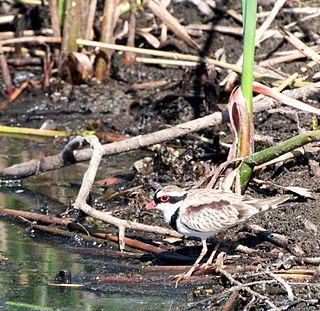
The Narran Wetlands, also known as the Narran Lakes, contained within the Narran Lake Nature Reserve, comprise a series of protected ephemeral lakes and swamps fed by the Narran River in the north-west of New South Wales, Australia. The 26,480-hectare (65,400-acre) reserve is located approximately 50 kilometres (31 mi) east of Brewarrina.
Chowilla Regional Reserve is protected area in the Australian state of South Australia located in the gazetted locality of Chowilla about 250 kilometres (160 mi) north-east of the state capital of Adelaide.
Widgeon Valley National Wildlife Area is a National Wildlife Area located near the south end of Pitt Lake in British Columbia, Canada. The property was purchased by the Nature Trust of British Columbia in 1973 and declared a National Wildlife Area by the Canadian Wildlife Service in October of that year. The Widgeon Valley National Wildlife Area is a biologically diverse marsh wetland. It is the traditional territory of various First Nations groups. The Widgeon Valley Wildlife Area is a protected wildlife area that is home to a number of sensitive waterfowl and fish species. The public uses the channels through the Widgeon Valley National Wildlife Area for recreational canoeing, anywhere else within the protected area is strictly off-limits to the public. There are future plans to develop interpretive trails through the park and open it to the public.

Lower Sula National Nature Park is a national park of Ukraine that covers the lower reaches of the Sula River as it enters the Kremenchuk Reservoir, 120 km southeast of Kyiv. The extensive marshes, swamps, and other wetlands of the area are important habitats for fish, waterfowl, and floodplain plants. The park is administratively in the Kremenchuk, Orzhytsia, and Semenivka raions of Poltava Oblast, and Zolotonosha Raion of Cherkasy Oblast.











